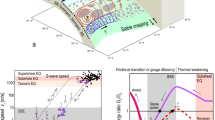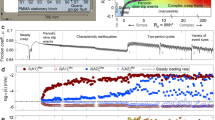Abstract
PRESENT earthquake mechanism models are predicated on the hypothesis of the formation of a dilatant zone in the region of the proposed break and the time history of physical rock properties that are a function of crack porosity. For example, field observations have shown drops in compressional wave velocity in earthquake areas prior to events. The anomaly persists for a time dependent on the source dimensions of the impending shock, and returns to normal prior to the event1–4. Velocity measurements made during laboratory fracture tests have shown a decrease in compressional wave velocity above approximately 80% of the fracture stress5,6. The effect is most pronounced normal to the direction of greatest compression. Similarly, as the fracture stress is approached the inelastic volumetric strain is the greatest7, indicating a definite correlation between velocity and inelastic volumetric strain.
This is a preview of subscription content, access via your institution
Access options
Subscribe to this journal
Receive 51 print issues and online access
$199.00 per year
only $3.90 per issue
Buy this article
- Purchase on Springer Link
- Instant access to full article PDF
Prices may be subject to local taxes which are calculated during checkout
Similar content being viewed by others
References
Nersesov, I. L., Semonova, A. N., and Simbireva, I. G., Physical Basis of Foreshocks (Nauha Publications, Moscow, 1969).
Scholz, C. H., Sykes, L. R., and Aggarwal, Y. P., Science, 181, 803 (1973).
Whitcomb, J. H., Garmany, J. D., and Anderson, D. L., Science, 180, 632 (1973).
Wyss, M., and Johnston, A. C., J. geophys. Res. (in the press).
Matsushima, S., Diaster Prev. Inst., Kyoto Univ. Bull., 32 (1960).
Gupta Indra, N., J. geophys. Res., 78, 6936 (1973).
Brace, W. F., Paulding, B. W., and Scholz, C. H., J. geophys. Res., 78, 3939 (1973).
Heflinger, L. O., Spetzler, H., and Wuerker, R. F., Rev. Sci., Instrum., 44, 629 (1973).
Spetzler, H., Scholz, C. H., and Lu, C. J., Pure and Applied Geophys. (in the press).
Author information
Authors and Affiliations
Rights and permissions
About this article
Cite this article
SPETZLER, H., MARTIN, R. Correlation of strain and velocity during dilatancy. Nature 252, 30–31 (1974). https://doi.org/10.1038/252030a0
Received:
Revised:
Issue Date:
DOI: https://doi.org/10.1038/252030a0
This article is cited by
-
Complexities of rock fracture and rock friction from deformation of Westerly granite
Pure and Applied Geophysics PAGEOPH (1993)
-
Interpretation of the Southern California uplift in terms of the dilatancy hypothesis
Nature (1977)
Comments
By submitting a comment you agree to abide by our Terms and Community Guidelines. If you find something abusive or that does not comply with our terms or guidelines please flag it as inappropriate.



